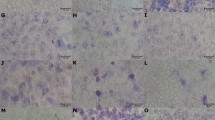Abstract
The tetrazolium salts (MTT, XTT, MTS, WST) based colorimetric assay or resazurin based fluorimetric assay are currently typical methods for cell sensitivity determination to anticancer compounds. We presented here a new rapid method for this purpose. This method uses a fluorescent dye named DCFH-DA which is previously taken as a intracellular probe for measurement of H2O2 levels within a cell. The application basis for this method lies in two facts: the membrane permeable feature of the final metabolite of DCFH-DA inside a cell, and the linearity relationship between cell number and H2O2 level. The results showed that there was a perfect association between cell number and fluorescent intensity determined by the DCFH-DA method, no matter whether using resuspended or adherent cells, and further 50% concentration of inhibition (IC50) comparison between data obtained by DCFH-DA method or MTT method using a positive known anticancer compound Baicalin showed that there were no significant differences in cellular sensitivity determination to compound Baicalin though there existed a relatively higher coefficient of variation of IC50 by the DCFH-DA method than that by the MTT method. Thus our data indicate that DCFH-DA might not only be a fine reagent for determination of H2O2 levels in cells but also an ideal fluorescent dye for cellular sensitivity test of anti-cancer compounds, and may be suitable for primary high-throughput drugs screening.



Similar content being viewed by others
Abbreviations
- MTT:
-
3-(4,5)-dimethylthiahiazo (-z-y1)-3,5-di- phenytetrazoliumromide
- XTT:
-
3′-[1-[(phenylamino)-carbonyl]-3,4-tetrazolium]-bis(4-methoxy-6-nitro)benzenesulfonic acid hydrate
- MTS:
-
3-(4,5-dimethylthiazol-2-yl)-5-(3-carboxymethoxyphenyl)-2-(4-sulfophenyl)-2H-tetrazolium
- WST-1:
-
4-(3-4-iodophenyl)-2-(4-nitrophenyl)-2H-5-tetrazolio)-1,3-benzenedisulfonate
- DCFH-DA:
-
2′,7′-dichlorfluorescein-diacetate
- H2DCF:
-
2′,7′-dichlorodihydrofluorescin
- DCF:
-
2′,7′-dichlorofluorescein
- DMSO:
-
Dimethyl sulfoxide
- PBS:
-
Phosphate-buffered saline
References
Bass DA, Parce JW, Dechatelet LR, Szejda P, Seeds MC, Thomas M (1983) Flow cytometric studies of oxidative product formation by neutrophils: a graded response to membrane stimulation. J Immunol 130:1910
Cory AH, Owen TC, Barltrop JA, Cory JG (1991) Use of an aqueous soluble tetrazolium/formazan assay for cell growth assays in culture. Cancer Commun 3:207–212
Du G, Han G, Zhang S, Lin H, Wu X, Wang M, Ji L, Lu L, Yu L, Liang W (2010) Baicalin suppresses lung carcinoma and lung metastasis by SOD mimic and HIF-1alpha inhibition. Eur J Pharmacol 630:121–130
Gao J, Morgan WA, Sanchez-Medina A, Corcoran O (2011) The ethanol extract of Scutellaria baicalensis and the active compounds induce cell cycle arrest and apoptosis including upregulation of p53 and Bax in human lung cancer cells. Toxicol Appl Pharmacol 254:221–228
Gonzalez RJ, Tarloff JB (2001) Evaluation of hepatic subcellular fractions for Alamar blue and MTT reductase activity. Toxicol In Vitro 15:257–259
Goodwin CJ, Holt SJ, Downes S, Marshall NJ (1995) Microculture tetrazolium assays: a comparison between two new tetrazolium salts, XTT and MTS. J Immunol Methods 179:95–103
Halliwell B, Whitemann M (2004) Measuring reactive species and oxidative damage in vivo and in cell culture: how should you do it and do the results mean? Br J Pharmacol 142:231–255
Hockenbery DM, Oltvai ZN, Yin XM, Milliman CL, Korsmeyer SJ (1993) Bcl-2 functions in an antioxidant pathway to prevent apoptosis. Cell 75:241–251
Ishiyama M, Tominaga H, Shiga M, Sasamoto K, Ohkura Y, Ueno K (1996) A combined assay of cell viability and in vitro cytotoxicity with a highly water-soluble tetrazolium salt, neutral red and crystal violet. Biol Pharm Bull 19:1518–1520
Marshall NJ, Goodwin CJ, Holt SJ (1995) A critical assessment of the use of microculture tetrazolium assays to measure cell growth and function. Growth Regul 5:69–84
Mosmann T (1983) Rapid colorimetric assay for cellular growth and survival: application to proliferation and cytotoxicity assays. J Immunol Methods 65:55–63
O’Brien J, Wilson I, Orton T, Pognan F (2000) Investigation of the Alamar blue (resazurin) fluorescent dye for the assessment of mammalian cell cytotoxicity. Eur J Biochem 267:5421–5426
Ottonello L, Frumento G, Arduino N, Dapino P, Tortolina G, Dallegri F (2001) Immune complex stimulation of neutrophil apoptosis: investigating the involvement of oxidative and nonoxidative pathways. Free Radic Biol Med 30:161–169
Page B, Page M, Noel C (1993) A new fluorometric assay for cytotoxicity measurements in vitro. Int J Oncol 3:473–476
Rhee SG, Chang TS, Jeong W, Kang D (2010) Methods for detection and measurement of hydrogen peroxide inside and outside of cells. Mol Cells 29:539–549
Royall JA, Ischiropoulos H (1993) Evaluation of 2, 7-dichlorofluorescin and dihydrorhodamine 123 as fluorescent probes for intracellular H2O2 in cultured endothelial cells. Arch Biochem Biophys 302:348–355
Scudiero DA, Shoemaker RH, Paull KD, Monks A, Tierney S, Nofziger TH, Currens MJ, Seniff D, Boyd MR (1988) Evaluation of a soluble tetrazolium/formazan assay for cell growth and drug sensitivity in culture using human and other tumor cell lines. Cancer Res 48:4827–4833
Takahashi H, Chen MC, Pham H, Angst E, King JC, Park J, Brovman EY, Ishiguro H, Harris DM, Reber HA, Hines OJ, Gukovskaya AS, Go VL, Eibl G (2011) Baicalein a component of Scutellaria baicalensis, induces apoptosis by Mcl-1 down-regulation in human pancreatic cancer cells. Biochim Biophys Acta 1813:1465–1474
Tammariello SP, Quinn MT, Estus S (2000) NADPH oxidase contributes directly to oxidative stress and apoptosis in nerve growth factor-deprived sympathetic neurons. J Neurosci 20:RC53
Twentyman PR, Luscombe M (1987) A study of some variables in a tetrazolium dye (MTT) based assay for cell growth and chemosensitivity. Br J Cancer 56:279–285
Wood ZA, Poole LB, Karplus PA (2003) Peroxiredoxin evolution and the regulation of hydrogen peroxide signaling. Science 300:650–653
Zamzami N, Marchetti P, Castedo M, Zanin C, Vayssiere JL, Petit PX, Kroemer G (1995) Reduction in mitochondrial potential constitutes an early irreversible step of programmed lymphocyte death in vivo. J Exp Med 181:1661–1672
Acknowledgments
The authors are grateful to Dr. Dawei Li’s lab, Shanghai Jiaotong University, for providing the Varioskan Flash Multimode Microplate Reader.
Author information
Authors and Affiliations
Corresponding author
Electronic supplementary material
Below is the link to the electronic supplementary material.
Rights and permissions
About this article
Cite this article
Mao, W., Chen, X., Yang, T. et al. A rapid fluorescent screening method for cellular sensitivity to anti-cancer compound. Cytotechnology 64, 451–457 (2012). https://doi.org/10.1007/s10616-011-9423-0
Received:
Accepted:
Published:
Issue Date:
DOI: https://doi.org/10.1007/s10616-011-9423-0




